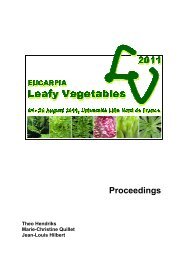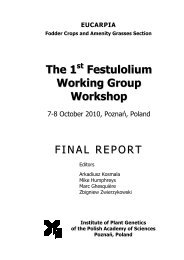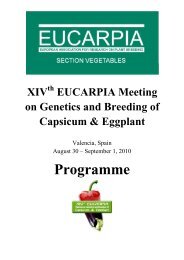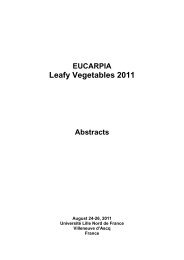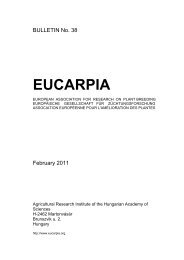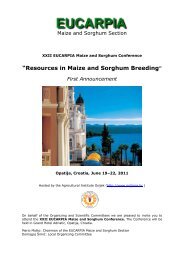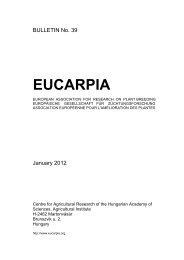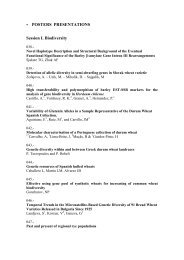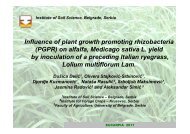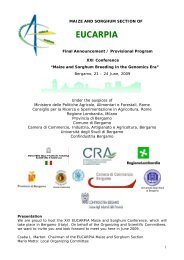Plant breeding for organic and sustainable, low-input agriculture
Plant breeding for organic and sustainable, low-input agriculture
Plant breeding for organic and sustainable, low-input agriculture
Create successful ePaper yourself
Turn your PDF publications into a flip-book with our unique Google optimized e-Paper software.
Quantitative-genetic basis of <strong>breeding</strong> maize<br />
<strong>for</strong> adaptation to <strong>organic</strong> <strong>and</strong> <strong>low</strong>-<strong>input</strong> farming<br />
Hartwig H. Geiger 1 , Walter Schmidt 2 , Henriette Burger 1<br />
1 University of Hohenheim, Stuttgart, Germany<br />
2 KWS SAAT AG, Einbeck, Germany<br />
Ecologically <strong>sustainable</strong> production of healthy food has become a major goal in present-day<br />
farming. Nutrient-efficient crop varieties with specific adaptation to <strong>organic</strong> farming may<br />
significantly contribute to achieve this goal. This paper presents quantitative-genetic data on the<br />
perspectives of <strong>breeding</strong> such varieties in maize.<br />
Large representative samples of testcrosses from the current KWS <strong>breeding</strong> program were<br />
evaluated under N-deficiency (LN = <strong>low</strong> N) <strong>and</strong> conventional (HN = high N) conditions in<br />
multi-environment field trials. In subsequent experiments additional testcross series, synthetic<br />
populations, <strong>and</strong> l<strong>and</strong>race-derived haploid (DH) lines were compared under <strong>organic</strong> (OF) <strong>and</strong><br />
conventional (CF) farming conditions.<br />
Soil nitrogen deficiency caused an average grain yield reduction of about 35-50 %. Phenotypic<br />
correlations between LN <strong>and</strong> HN were moderate to high <strong>for</strong> r<strong>and</strong>om samples of test-cross<br />
materials <strong>and</strong> <strong>low</strong> to moderate <strong>for</strong> single crosses selected <strong>for</strong> specific adaptation to LN or HN<br />
conditions. Significant genetic variation existed <strong>for</strong> the reaction to N-deficiency stress.<br />
Heritability coefficients were similar under LN <strong>and</strong> HN. Molecular marker studies revealed eight<br />
quantitative trait loci (QTL) <strong>for</strong> yield under LN jointly explaining 70 % of the genotypic<br />
variance. Growth chamber studies indicated that lateral root development of seedlings correlates<br />
with tolerance to N-deficiency.<br />
Grain yields under OF compared to CF were reduced by 5 - 25 % depending on the test<br />
environments <strong>and</strong>, to a lesser extent, the genetic material. Only small to moderate phenotypic<br />
correlations existed between OF <strong>and</strong> CF <strong>for</strong> grain yield but strong ones <strong>for</strong> plant height <strong>and</strong> dry<br />
matter content. Re-evaluation of the top genotypes confirmed their specific adaptedness to OF or<br />
CF or both. Testcrosses of l<strong>and</strong>race-derived DH-lines were about 20-25 % <strong>low</strong>er per<strong>for</strong>ming<br />
that those of modern inbred lines, but the difference was smaller under OF than under CF. Open<br />
pollinated populations synthesized from superior inbred lines per<strong>for</strong>med much <strong>low</strong>er (20 - 30 %)<br />
than predicted by quantitative genetic theory. Again, the difference was smaller under OF.<br />
Data demonstrate that significant genetic variation exists in modern Central European maize<br />
germplasm <strong>for</strong> tolerance to N-deficiency <strong>and</strong> adaptedness to <strong>organic</strong> farming. Extending the<br />
scope of hybrid maize <strong>breeding</strong> to these attributes should soon furnish varieties satisfying the<br />
needs of <strong>low</strong>-<strong>input</strong> <strong>and</strong> <strong>organic</strong> farming.<br />
6




